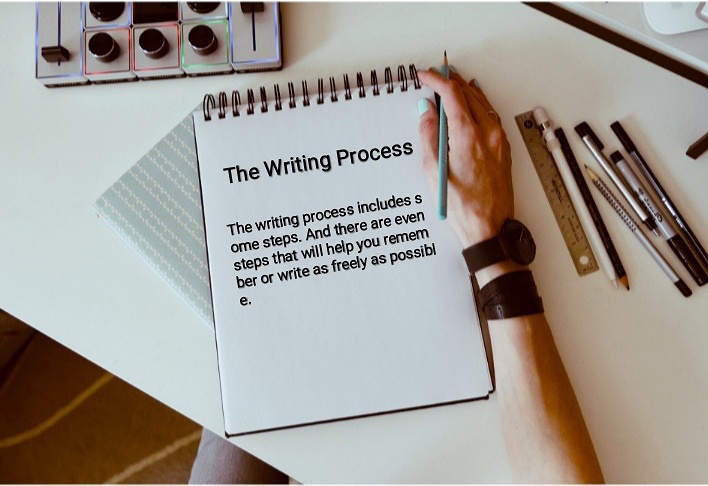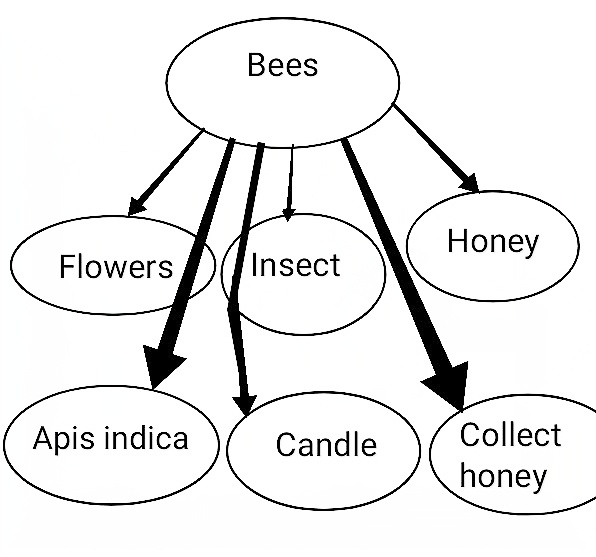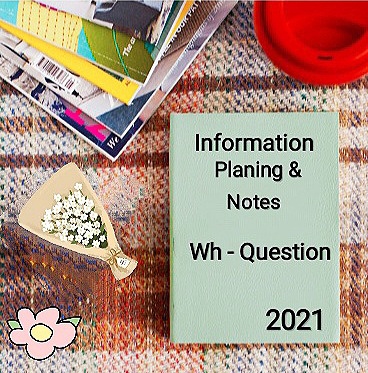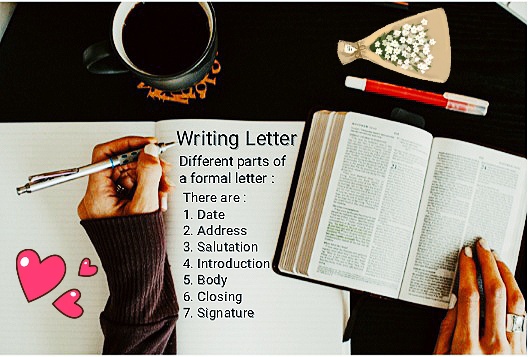The Writing Process to Elementary Students

The process of writing includes some steps. When you want to write a letter to your friends, relatives or to the Headmaster of your school, you should follow that process. Again, if you want to write a paragraph, composition or a story, you should know about the process. This process will help you to write freely.
Now look at the three (3) main stages of writing process :
Preparing to write > Drafting > Revising
Preparing to write > Drafting > Revising
The writing process also depends on :
- Why you are writing (purpose)
- Who are going to read it (e.g. friend, parents, Headmaster, Principal)
- What are you writing about (content)
- Where you are, how much time you have to write, etc. (situation)
In brief, the process of any piece of writing depends on:
- purpose
- readers
- content
- situation
Let Us Now Move to The Steps in Details

Preparing to Write

We need some preparations to write. When we write, we think of the purpose, content and situation of writing. Preparations may also differ. For example, your letter to your friend is different from the letter to your parents. Again, when you are very busy, you send a very short message. But when you are not so busy, you could write a longer text.
What You Should do First at The Stage
Gathering Idea:
Gathering ideas or information is important for your writing. Brainstorming can help you gather your idea.
Brainstorming:
It means you 'storm' tour brain or search your brain for ideas. Take five (5) minutes if you do it alone and take more time if you work with a partner or in a group. This is a very speeds process. So, here you:
It means you 'storm' tour brain or search your brain for ideas. Take five (5) minutes if you do it alone and take more time if you work with a partner or in a group. This is a very speeds process. So, here you:
- Write down very quickly.
- Write down everything that comes to your mind. Don't think if they are useful or not.
- Write down the main points only.
- You could write down the points in words or process. Never think that you must write sentences.
Now, think about the idea for a paragraph about bees. Here you can visualize the following images:

Thus the following points can come into your head from brainstorming:

The Next Step is Speed Writing:
This is a kind of activity for writing freely.
- Take five/six (5/6) minutes.
- Write as much as possible on a topic.
- Write whatever comes into your head.
- Continue writing, don't stop unit the time is up.
- Don't worry about correction, spelling or neatness at this stage.
Asking Wh-Question
To collect information at this stage you can ask yourself 'Wh' questions. But, here again, it depends on content. For example, you can ask questions about 'Bees' like :
- What are these words known as?
- When will you give up smoking?
- What do they do?
- How long was the journey?
- Where do they live?
- Where are they sitting now?
- What do they live in?
- When did you reach your destination?
- Why dou look so bored?
- What an amazing speech?
- How also do they help us?
- When do you go to market?
- Which nouns can you count?
- Whose book is this?
- Why do they like you?
- How many sentences are there in the letter?
But here you are writing as much as possible. So, don't think much about grammatical rules, structures, spelling, and punctuation. Look at the sample speed writing on 'Bees'.
- Bees are think insects. They are hardworking and quick.
- They from flowers to flowers. They make honey. We take honey.
- It is very tasty and sweet. They live in bee hives.
- They take honey and save honey. Many people collect and sell honey.
- Collecting honey is not easy.
The Next Step of Your Writing is 'Planning'

After Brainstorming, asking 'WH' questions to yourself and speed writing, you have got your topic, sufficient ideas, and information in mind in your notes. Now it is time to make a plan foe your writing.
Planning Includes:
- The length of the writing
- Number of paragraphs
- How should I introduce the topic?
- How should I conclude?
- Which information should go first and the rest?
Drafting
The actual writing begins with 'drafting'. In drafting, you will carry out your planning. Drafting needs revision. So you can allow space after every line.
The actual writing begins with 'drafting'. In drafting, you will carry out your planning. Drafting needs revision. So you can allow space after every line.
Below is a sample drafting of a paragraph on bees.
Bees are insects. They fly flower to flower to collect honey. They live in bee hives. They deposit honey there. There are some people, who collect honey from bee hives. They sell honey. We eat honey. It is very tasty, sweet and good for health. Collecting honey is not easy. People get stung by bees -------.
Revising
It is the last stage before we produce the actual writing. You can revise while drafting or after you have finished drafting. When you revise, you must consider:
- if it is appropriate for the readers.
- if ot clearly states your purpose.
- if it is well-organized.
- if it contains all things you wanted to write.
Understanding The Organization of Writing
The paragraph is a group of sentences about a topic. There are three (3) parts of a paragraph.
These are:
- The Introduction
- The Middle
- The Conclusion
Introduction/ Topic Sentence :
The introduction of a paragraph contains an introductory sentence. It is called a topic sentence. Generally a begins with it. The topic sentence introduces your topic.
To write a good topic sentence:
- State the topic clearly so that the reader can understand what you are going to write about.
- Tour topic sentence should be attractive.
Middle:
The middle of a paragraph contains supporting ideas. Here you narrate, explain and thus support what you said in the introduction. It should contain the details of your description.
To write the middle:
- Narrate everything you want to write about your topic.
- If needed, classify your ideas.
- Put them clearly one after another and make a link between them.
Conclusion:
It is the last part of your paragraph. Here you make a final say about your topic. To write a conclusion-avoid repetition and sum your ideas.
Below is a Simple Paragraph Withe Different Parts
Mobile Phone, Topic sentence :
The mobile phone is an important device of communication. It helps us to communicate with others in the shortest possible time.
Middle/ Supporting ideas:
The main facility of the mobile phone is that you can take it anywhere with you. It is very popular for many reasons. Firstly, it is not very expensive. So, most of the people can buy it. Secondly, we can also use it for others purposes like sending text messages, taking photographs and selfies, strong data, exploring websites. Now the mobile phone is widely used for internet communication. The mobile phone is a wonderful blessing of modern communication system.
Conclusion: We cannot imaging our life without it.
Letter Writing
- We write letters to our friends and relatives to know about them.
- We write for sending and receiving information.
- We write letters to different institutes, organizations for seeking specific information, admission and also for jobs.
Types of letters:
- Personal letter
- Formal/ business/ official letter
Purposes of Personal Letter:
Below are some purpose of a personal letter:
- to thank
- to apologize
- to invite
- to make an arrangement
- to request
- to reply to another letter
Different Parts of a Personal Letter
The five parts of a personal letter:- Heading
- Greeting/ Salutation
- Body
- Signature
- The Heading : This includes the recipient's address and the date (in some cases, it's to just write the date)
- The greeting/ salutation : The act or an instance of welcoming (Dear ........,)
- The body : The main text of your letter
- The complimentary closing : The closing includes a short capitalized expression, such as "Sincerely," or "Love"
- Signature : Name and signature
Below is a sample of personal letter. Look at it carefully to identify different parts and the way they are presented in a letter.
Instruction : Suppose you have been ill for a few days. Therefore you missed some classes. Now, write a letter to your friend telling him to provide information and materials you missed during the time.
November 04, 2021 [Heading]
Mr. John
Care of Mr Smith
Flat No. F-34
City London [Greeting/ salutation]
Dear friend
Hope you are well. I am also fine. You know that I have been seriously ill for last weeks. I have missed a lot of things done in the classes. Our examination is near. So, I am worried about it. [Body]
Hope you are well. I am also fine. You know that I have been seriously ill for last weeks. I have missed a lot of things done in the classes. Our examination is near. So, I am worried about it. [Body]
I request you to inform me what important things have been taught in the classes. Please write in details about English, Mathematic and Science. [Body]
I am looking forward to receiving your reply. I hope that you will help me to make up the missed lessons. [Body]
Your Friend [Complimentary Closing]
Mr. David [Signature]
City Town
London
Mr. David [Signature]
City Town
London
Here is another example of a personal letter. Now discuss in pairs or groups and identity different parts of this letter. Also notice the language of the letter and tell your friends or teacher if it is easy or difficult.
Do you think that it is possible foe you to write the some type of letter on another topic in this way? You can write another letter and show your friends or teacher.
Formal Letters
Objectives : We write a formal letter to request for something or asking for something or getting some information.

Different parts of a formal letter: There are seven (7) parts of a formal letter.
There are:
- Date
- Address
- Salutation
- Introduction
- Body
- Closing
- Signature
- Date : The date is placed at the top of the page for any business contact. It is an official record of correspondence that may be kept for future reference.
- Address : The address of the person receiving the correspondence includes formal name, street address, city, state and postal code.
- Salutation : The salutation is the formal way of addressing a person. Common salutations are Dear or Dear Mr. Joy, Dear Sir/ Madam, etc.
- Introduction : The first few sentences of a letter are introductory in nature. The introductory section introduces the subject of the letter.
- Body : The body of the letter shares most of the information. It also contains some supporting ideas.
- Closing : The closing of the letter summarizes what the letter was about.
- Signature : It contains the writer's name, address, etc.
Instruction : Suppose there is a Computer Training Institute in your locality. You have noticed the advertisement of admission into a 'Basic Course'. You want to attend the course. Now write a letter to the Coordinator requesting him to send you an admission form.
October 17, 2021 [Date]
Mr. Smith [Address]
Coordinator
Computer Hub
32, House Road
United Kingdom [Salutation]
Dear Sir,
I have seen your advertisement regarding the admission in 'Basic Computer Course' in a local daily. [Introduction]
I am a student of class Eight (8). I am very interested to enroll myself in the course. Now I need an admission form. [Body]
I, therefore, request you to send me an admission form so that I can apply for it. [Body]
Sincerely yours, [Closing]
David Miller [Signature]
Class Viii (eight)
Roll No 05 (five)
UK Pilot School
United Kingdom
Here is another example of a formal letter. Now discuss in pairs or groups and identify different parts of this letter. You may also notice how the main point is presented in the letter. Do you think that it is possible for you to write another letter on the same type of problem you notice?
Writing E-mail
E-mail is valuable mode of communication. It is now widely used in academic, businesss and social settings. Thus, depending on your purposes, the text of the e-mail may be different.
Basic types:
E-mail could be both formal and informal. The formal emails are used to communicate in academic, official and business settings. On the other hand, the informal emails are used to communicate in social setting like communicating with friends, guests and so on.
E-mail could be both formal and informal. The formal emails are used to communicate in academic, official and business settings. On the other hand, the informal emails are used to communicate in social setting like communicating with friends, guests and so on.

Features of E-mail
Features of E-mail
- It is generally brief.
- The salutation should be formal and informal depending on contexts.
- You do not need to write 'the date'
- You do not need to write the 'address of the receiver' but you have to use the recipient's e-mail ID.
- You do not need to write your complete address.
- You need not bother about signature.
Formal E-mail
Formal e-mails are used in academic, official and business communication. When you are writing a formal e-mail, you must remember the following things :
- You should write the e-mail ID carefully.
- You should write the subject of your e-mail briefly.
- Your language should be formal.
- Avoid contracted forms like 'it's. haven't' rather you should write 'it is, have not', etc.
- Mention the purpose of writing very clearly.
- The salutation should be formal as 'Dear HeadMaster', 'Dear sir', 'Dear Madam', 'Dear Choudhury', etc.
- Should have a formal closing such as 'your sincerely, your obedient', etc.
- You may attach other files if needed.
Instruction : Suppose there is an ICT in your school. You want to be a member of that club. Now write an e-mail to the Headmaster of your school for the membership.
To: akramali55@yahoo.com [Address of the recipient]
Subject: For the membership of ICT club [Subject]
Dear Sir [Salutation]
I am a student of class eight (8) of your school. I feel that knowledge of ICT is very essential for us. For this reason, I want to be a member of our ICT Club. I am attaching here the prescribed form for the membership. [Body]
I hope that you would be kind enough to enlist my name as a member of our ICT Club. [Body]
Your sincerely [Closing]
Monika Asrafi
Class VIII
Role No. 04
Informal E-mail
Informal e-mails are mostly used in social communication like communicating with friends, parents, relatives, classmates. It is also used for inviting a huge number of people to join a festival, gathering, etc. Informal e-mails can be different types depending of the purposes.However, the most common features of informal e-mails are:
- You should write the e-mail address carefully.
- Just write the subject of your e-mail.
- Your language should not be formal.
- General contracted forms like 'it's. haven't' are widely used here.
- Mention the purpose of writing briefly.
- The salutation should be informal as 'Hello', 'Dear David', 'Hello everyone', etc.
- The closing is informal like your son, your friend, love, regards etc.
- You may or may not (depending on situation) write your name.
- You may attach files if needed.
Instruction : Suppose you are writing an e-mail to your friend for borrowing a book.
Example of an Informal E-mail
To
davidsm55@gmail.com [Address of the recipient]
Subject: Borrowing a book [Subject]
Hello! [Salutation]
Can you bring my friend Smith tomorrow? I want to read it. [Body]
Don't forget to keep it in your bag. See you tomorrow. [Body]
Best regards [Closing]
Developing Composition
What is a composition?A composition contains a number of paragraphs which discuss one main idea. The main idea is the 'topic' which you are going to write about. A good composition has the same basic patterns as a paragraph does.
The structure of a composition/essay: A composition has three main section. These are Introduction, Body, Conclusion.
How to the 'Introduction' of your composition/ essay:
- The first paragraph of your composition is the Introduction. It states the main idea of your composition. The introduction should be attractive or strong enough to catch the attention of the readers. The most important part of the introduction is To tell what you are going to write about. Just as the topic sentence of a paragraph states the main idea of a paragraph, an introductory paragraph expresses the main idea of a composition. It is usually a single sentence.
- The Introduction tells the subject of your composition and makes a clear statement about your topic.
How to Write The 'Body' of Your Composition
The body of a composition consists of different paragraphs. But each paragraph of the body focuses one idea. Again, this idea should support what is stated in the introduction. In the body of the composition, the main idea of the introduction is narrated, explained and analysed.
The write the body of your composition:
- Write one supporting idea in one paragraph.
- Each paragraph of your composition must contain a topic sentence, a middle and a conclusion.
- Support your idea with examples and explanations as clearly as possible.
The difference between introduction and conclusion:
- The introduction states what you are going to write.
- The conclusion sums up what you have already written.
Type of Composition
Composition can be off many types. However, the major types are:i. Narrative
ii. Descriptive
iii. Persuasive
iv. Informative/ Xpository
i. Narrative : It tells a story or presents a sequence of events as they occurred in time. The purpose of this is to readers an impression of actual event. Here, 'what happened' and 'how happended' are discussed.
- It is about historical events or accounts of people's life and events.
- It answers questions like who, what, when, where and how.
ii. Descriptive : It is like describing a person, place or thing including details that appeal to the readers. This kind of paragraph appeals to our senses-sight, smell, hearing, touch and taste.
It describes :
It describes :
- The details about a place, event, person or thing
- Ways they attract our sense
iii. Persuasive : It contains arguments. Writers try to give some reasons to support their arguments.
It contains
- arguments one after another
- reasons supported by clear ideas
iv. Informative/ Expository : It explains facts or ideas. It also explains the process.
Read the following example of developing composition on 'The Season You Like Most'. Read the first two statements and decide which one is more appropriate for an introduction.
Read the following example of developing composition on 'The Season You Like Most'. Read the first two statements and decide which one is more appropriate for an introduction.
Three are six seasons in Bangladesh and spring is one of them. It is called the king of all seasons. [Not a good introduction]
The beauty of spring is different from the rest of the seasons. I like it for many reasons such as its beautiful colour's, fragrances and decorations. [Good introduction]
Spring is my favourite season. I like it very much because its beauty is different from all other seasons. [Conclusion]
The Body of The Composition
In a short composition, the body includes three or four paragraphs. In each paragraph you will write about only one idea. Thus, in a composition of 200 words, you can write three or four major ideas. But remember that all paragraphs of the body should support the main idea you provided in the introduction.
- description of spring
- its beauty
- how is it different from other seasons
Spring in Bangladesh
The topic sentence : The beauty of spring is different from the rest of the seasons. I like it for many reasons such as its beautiful colour's fragrances and decorations.
Supporting ideas/ Body : According to Bangla calender, the months of Falgun and Chaitra are called the spring. The weather of this seaso is neither hot nor cold. Spring gives us relief from winter. During spring nature seems calm and quite. The sky looks clear and there are no nature disasters like storms, cyclones, draughts, etc. during spring. Thus the physical atmosphere of spring is wonderful.
As soon as spring sets in, a gentle breeze from the south beging to blow. It spreads the sweet smell of flowers all-around. The wandering song of the cuckoo attracts us a lot. It touches the heart of the poet writers. Many poets have written poems and songs about spring.
Conclusion
Spring is the most colorful and beautiful season in Bangladesh. It has a deep influence on our sight and mind. I love it so much. It is my most favourite season.
Note : You must have noticed that the first paragraph describes the physical features of spring. The second paragraph tells us about the boundless beauty of spring. Here we have a wider description of spring. The third paragraph describes the influence of spring on human mind and heart. Thus different paragraphs of a body give us different and separate ideas. But these must support the main ideas.
["The research is clear: those who know and use the writing process become better writers."]
(FAQs) on The Writing Process to Elementary Students
How I teach the writing process in elementary?Answer: Last year, a panicked teacher e-mailed me and said they gave a practice writing test and her students didn't follow the writing process. They went straight to writing the one and only draft they would eventually launch. It's a writing teacher's worst nightmare. So, how do you make sure your students know the writing process and actually use it?
What is the writing cycle?
Answer: The writing cycle - also known as the writing process - is a simple set of steps introduced for children of early age. It can be applied to any writing activity, especially those that are long, such as a homework task.
The idea is that this process mimics the steps taken by professional writers in real life. And gives children a clear framework to follow with any writing.
What are the elements of the writing process?
Answer: Although we can parse the writing process in a variety of ways, each with its own limitations, we believe it is beneficial to view writing as a three-step repetitive process of innovation, composition, and revision. Some students come to college with strategies to manage all these steps in the writing process; Others have habits that have served them in high school but limit them to college; There is still no strategy for writing to others. First-year writing teachers will benefit from knowing what a student's writing process is. They will also benefit from an array of methods to help their students move forward successfully through the writing process.














No comments:
Post a Comment